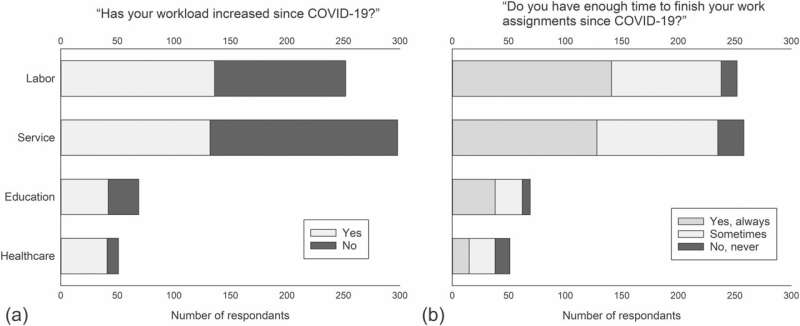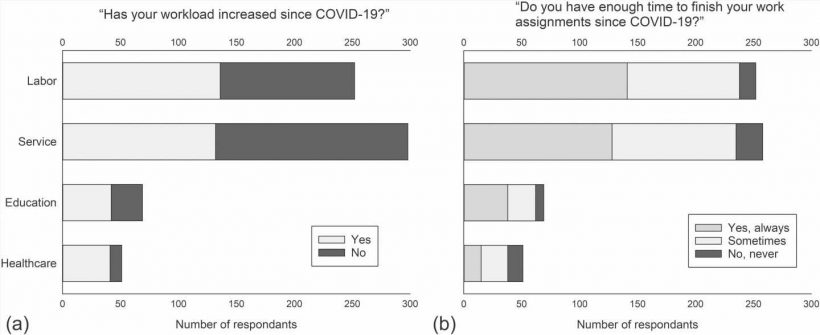
A new study from the University of Cincinnati examined the impact of workplace stress and provided insights for organizations to explore ways to reduce workplace stress for a better and healthier working environment.
The study had two parts: a survey in which respondents described their experiences of workplace stress during the COVID-19 pandemic and a quantitative study using saliva cortisol as a biomarker of stress along with a stress diary to find out where and when workplace stress commonly occurred.
The first part of the study, published in the Annals of Work Exposures and Health, detailed increased stress levels, stressor events and other perceptions of stress from at-risk workers during COVID-19.
“Stress is often overlooked in the workplace, and we tend to look at traditional health hazards like chemical exposure to gases and particles or physical hazards like falls, cuts and burns,” says Jun Wang, Ph.D., of the Department of Environmental and Public Health Sciences in the UC College of Medicine and faculty mentor on the study.
“Stress, even though not as ‘tangible’ as chemical or physical hazards, can deeply affect workers’ mental health and lead to workplace injury and illness. Workplace stress issues were amplified during COVID-19 because many people worked from home. Many health care professionals were also overloaded due to the increased number of patients and less resources.”
The UC research developed an in-depth, work-related stress survey that incorporated many aspects of work conditions, work context, work-life balance and the health of employer-employee relationships with a focus on COVID-19-related stressors. The cross-sectional survey was completed by 670 workers in a variety of clearly distinguished sectors, including manual labor, business settings, health care and education.
More than 50% of the participants reported experiencing an increased workload since the onset of the pandemic with some sectors, like health care, reporting an increased workload more frequently, at 80%. Around 55% of respondents believed they could be exposed to COVID-19 in their workplace, ranging from 52% of business/office service workers to 77% of health care workers, and this perception of COVID-19 exposure led as the greatest stressor.
“As workplaces navigate past the pandemic, occupational stress should be addressed head-on through providing expanded resources to assure work stress associated with future pandemics are mitigated appropriately,” says Wang. “Whether the stressor is associated with irregular shift work or psychosocial aspects, many of these stressors have the possibility to become exacerbated by external factors such as pandemics or economic downturns which we are experiencing right now.”
The second part of the study, published in the International Journal of Environmental Research and Public Health, found a relationship between occupational stress and increased salivary cortisol levels. For the study, 15 participants were recruited via email and social media. Each was given a kit containing a blank work stress diary, a sampling log, study protocol and nine saliva collection vials.
“As the body’s main stress hormone, cortisol is released each day, with levels typically highest in the morning and tapering off throughout the day,” says Thomas Gerding, Ph.D. candidate and primary student investigator in this study.
“Traditionally, cortisol-based stress research required [participants] to come to a clinic around noon and [have] their saliva collected by a professional. This method is not suitable to identify the fluctuation of cortisol throughout the day, and it is hard to correlate them to specific stressors such as workplace conflict and work-life balance issues.”
During three consecutive working days, participants were asked to document anything causing stress during working hours in the diary which included sections for occupation, date, time of day, intensity of stress on a scale of 0 to 5 (no stress to the highest level of stress), stress duration, situation description, triggering event, if applicable, and any emotional behavioral reaction. They were also asked to describe whether the day would be considered typical of their job.
“The whole idea of this project is to create a way for people to investigate their stress level by using this kit themselves, developing self-measures of saliva,” Wang says. “They collect the saliva in the tube, then they freeze it, and they also document what is likely the stressor event. If you feel stress, what is it? What is the nature of the stress?”
Wang says measuring cortisol changes may provide insights into types of occupational stressors and how these may be minimized. The goal of subsequent research in this area is to establish a measurable baseline for stress, with an emphasis on high stress occupations such as home health care workers or firefighters.
“In the future we will try to include a way to measure the baseline for each person so when they are comparing their stress level, they are comparing to their baseline,” Wang says.
“Stress is something that has been understudied in the past. A lot of people don’t take stress as critically as other aspects of the workplace environment. When people have stress or a mental health issue, like depression, a lot of times people don’t talk about those things. Moving forward, it is critical to build a healthier workplace with fewer hazards and less stress.”
More information:
Thomas Gerding et al, An Investigation into Occupational Related Stress of At-Risk Workers During COVID-19, Annals of Work Exposures and Health (2022). DOI: 10.1093/annweh/wxac076
Thomas Gerding et al, Stressed at Work: Investigating the Relationship between Occupational Stress and Salivary Cortisol Fluctuations, International Journal of Environmental Research and Public Health (2022). DOI: 10.3390/ijerph191912311
Journal information:
International Journal of Environmental Research and Public Health
Source: Read Full Article






